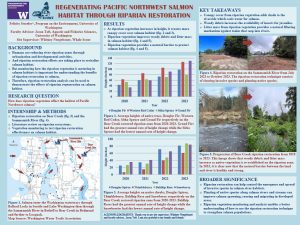REGENERATING PACIFIC NORTHWEST SALMON HABITAT THROUGH RIPARIAN RESTORATION
Salmon in the Pacific Northwest serve not only as an important keystone species but also provide local businesses, communities and tribal nations revenue through fisheries. Therefore, protecting the habitats of rivers and streams ensures that salmon can continue to provide for the ecosystems and people of Washington. However, in recent years, human developments such as urban areas, roads and dams are impeding and taking over salmon riverine habitat, thus making it increasingly difficult for salmon to migrate back to their spawning grounds. The purpose of this internship with the non- profit organization Whale Scout was to protect salmon habitat through restoring the riparian zones (vegetated areas adjacent to rivers and streams) of the Sammamish River and Bear Creek. The methods used to restore the riparian zone were invasive vegetation removal and native planting. Field monitoring of both sites was also carried out to document the growth and health of the restored areas. This study indicated that the native tree and shrub health and growth improved as invasive species were taken out. Consequently, the resorted riparian zones of the Sammamish River and Bear Creek were able to enhance salmon habitat by adding shade cover to make the water cool and providing woody debris and litter to help promote water filtration and important nutrient cycling. Ultimately, this study illuminates the benefits of native vegetation to salmon habitat, suggesting that riparian restoration can be an effective tool in protecting salmon populations of the Pacific Northwest.
